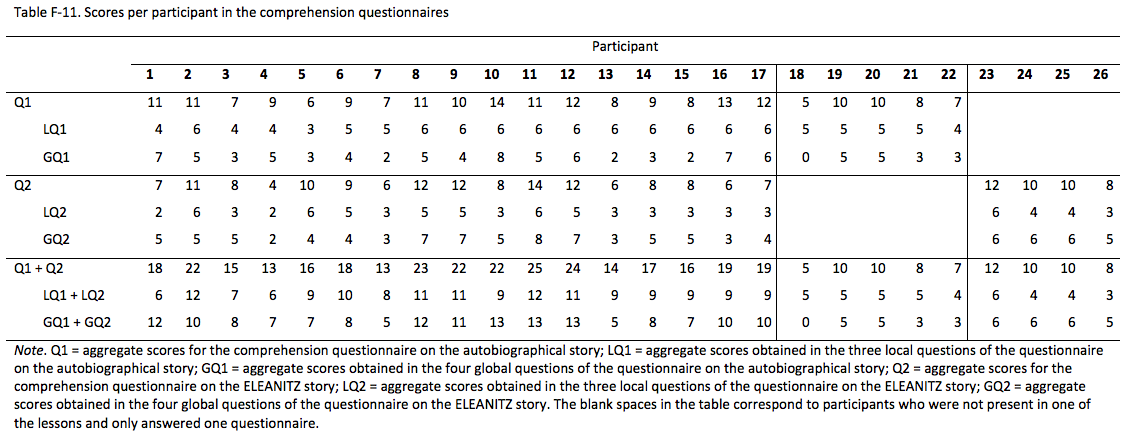This case study examines the effects of an EFL teacher’s autobiographical story on 26 Spanish primary students in terms of comprehension, raising interest, engagement, motivation and willingness to communicate in L2, by comparing it to a story in the ELEANITZ multilingualism project. A questionnaire, a behavioural observation instrument and a post-test survey were used to collect data. The data was analysed using descriptive statistics, t-test, effect size (Hedge’s g) and content analysis. The results reveal that the students understood the autobiographical story better, found it more interesting, it triggered their personal stories and increased their willingness to communicate in English.
Stories are the stuff life is made of, it could be argued paraphrasing Shakespeare. Narrative is basically the way in which humans think, and construct meaning and identity; we experience, organise, understand, explain and project life as a series of narrative episodes or stories (Howe & Johnson, 1992; Rossiter, 2002; M. Turner, 1996). Coupled with this, storytelling is the means by which narrative is communicated (Daniel, 2012).
The cognitive power of stories makes them a widely used resource in teaching and learning processes and an important research topic in education. In particular, this study focuses on the use of the autobiographical story in the context of teaching and learning English as a Foreign Language (EFL). More specifically, it aims to explore the effects of the teacher’s personal stories on the comprehension, interest, engagement and motivation of primary students learning EFL.
This case study tackled those objectives by telling a group of fourth grade primary students an autobiographical story and a story contained in their regular ELEANITZ course book on different lessons, each followed by a questionnaire to assess comprehension and motivational aspects. Additionally, both lessons were recorded on video and the students’ engagement was assessed with a behavioural observation instrument. Thus, the ELEANITZ story served as a benchmark against which the results of the autobiographical story could be compared and discussed.
The following sections of the introduction provide essential information on the context for the study, and state the research questions that have guided it. The second chapter consists of a brief literature review closely related to the research questions. The methodology applied in this case study is presented in the third chapter, including information on the participants, the procedure, the materials used and the instruments for data collection. The fourth chapter presents the data analysis and results obtained in the study. Finally, the fifth chapter discusses the results, and the sixth chapter summarises the conclusions of the study. The closing sections of the document contain the references and six appendices.
This case study was conducted during my school placement, which lasted 12 weeks and was held at Astigarragako Herri Eskola, a state-funded school located in Astigarraga (Gipuzkoa, Spain). It has 537 students, 236 of them in pre-primary or the Early Years Foundation Stage (EYFS) and 301 in primary. There are two or three classes per grade with up to 25 students per class in primary.
This school follows the ELEANITZ multilingualism project, which comprises story-based learning materials for EFL created in the Basque Country. As part of the school policy, EFL teachers pretend to be native English speakers.
Along the school placement, some teachers claimed that in general students lacked motivation to learn EFL, regardless who their EFL teacher was. On the other hand, I observed that the EFL teachers preferred to keep the same rhythm for all the classes in the same grade, that is, to cover the same part of a particular unit on the same week with all classes. That caused the need to make occasional adjustments on the lesson planning, for instance, when a public holiday led to one class missing a lesson in a particular week. Often, the adjustments introduced in the lesson planning consisted on a storytelling activity using materials other than ELEANITZ.
Previous studies suggest that the autobiographical story may have some features that could complement the ELEANITZ stories used at the school. Hence, the autobiographical story might be a suitable candidate for the extra storytelling activities that the EFL teachers occasionally introduced in their lesson planning at school.
There are numerous studies on the use of autobiographical storytelling to reflect on teacher practice and as a means to improve university-led teacher training, as well as on the use of autobiographical storytelling produced by students to promote the development of identity and for language learning. Yet, less attention has been paid to the use of the teacher’s autobiographical story in the context of EFL learning.
A previous study conducted on university students of EFL (Kazuyoshi, 2002) reports that personal stories told by the teacher in the context of EFL teaching and learning can influence the interaction between teacher and students, as well as among students; enhance willingness to communicate using the second language (L2) in class; change students’ attitude towards mistakes in L2; raise engagement and motivation, and serve as a catalyst to create a collaborative learning environment. All those are key factors for success in the process of learning a foreign language. However, little is known on the effect of the teacher’s personal stories on children learning EFL, and this study aims to explore this issue.
The ELEANITZ story offered an excellent benchmark against which the autobiographical story could be compared, since the ELEANITZ material had been designed by experts and had undergone extensive testing and research for several years. However, I had concerns about how well the students would understand an autobiographical story created by me, as it would affect competence and, thus, motivation.
On the other hand, I wanted to cause minimal disturbance in the original lesson planning of the EFL teacher. For that reason, introducing one lesson around an autobiographical story close to another lesson where the story of a new ELEANITZ unit was going to be introduced for the first time seemed like a good idea.
As a further development of what has been explained about the context in the previous section, the following research questions guided my study:
- What are the differences between an autobiographical story and a story in the ELEANITZ course book in terms of comprehension by the students?
- What are the differences between an autobiographical story and a story in the ELEANITZ course book in terms of raising interest and motivation among the students?
- What are the differences between an autobiographical story and a story in the ELEANITZ course book in terms of use of English by the students?
This chapter outlines briefly topics that are closely related to the research questions that guided the study. In particular, it reviews the roles of stories in education and language teaching and learning, the use of autobiographical stories in education, and some specific aspects of storytelling that can have an influence on comprehension.
The opening section presents the different views on how stories can be used in educational contexts. The second section narrows the focus to summarise how stories are often used in language teaching and learning. The third section gives an overview on the role of stories in the multilingualism ELEANITZ project created in the Basque Country. The fourth section deals with ways to use autobiographical stories in education, particularly in language teaching and learning. The fifth section explains briefly how the views on the way to use stories relate to points of view on wider issues regarding the communicative approach in language teaching. Finally, the last section outlines the main variables of storytelling with an effect on comprehension that are relevant to this case study.
It could be argued that regarding their main purpose when used in education, narrative and stories form a continuum, where storytelling just for the sake of it would be on one end, and using stories as a hook to engage students in learning a given topic (Freadman, 2014) would be on the other end.
Therefore, on the one hand, some authors claim that a story is a work of art, whose primary purpose, even when used in education, is to give joy, not to instruct “using” it as a text (Bryant, 2008; Fox, 2013). Hence, stories should be given to children as a gift, and not a prize that needs to be gained (Pennac, 2008).
On the other hand, it is believed that since from a very early age children are familiar with narrative structure and conventions, stories can act as a valuable vehicle for learning, for they can convey new learning content wrapped in a recognisable and memorable context (Ellis & Brewster, 2002; Garvie, 1990). Thus, stories are seen by others as powerful tools to develop a wide variety of competences, skills, knowledge, attitudes and subjects in the curriculum (Ellis & Brewster, 2002; Howe & Johnson, 1992; Zaro & Salaberri, 1995), in addition to the most obvious communication competences, which the next section will deal with.
In agreement with the more instructional view on stories, from the point of view of language teaching and learning stories are often used to:
- Introduce new vocabulary and structures, which will be easily acquired thanks to the fact that children enjoy listening to stories over and over again (Ellis & Brewster, 2002).
- Enhance fluency in the four skills (Paran & Watts, 2003; Wright, 1995).
- Improve pronunciation, including stress, rhythm and intonation.
- Stimulate reading and writing.
Above all, stories provide vital scaffolding to children in the challenging process of language acquisition, due to the familiar structure of narrative. That encourages the development of the seven core strategies for the construction of meaning, namely, predicting, making inferences, self-questioning, comprehension monitoring, summarising, determining importance and focusing on text structure (Dewitz, Leahy, Jones, & Sullivan, 2010).
As a result, there are numerous guidelines for choosing, adapting and telling stories with language learning in mind (e.g. Bryant, 2008; Ellis & Brewster, 1991, 2002; Fox, 2008; Garvie, 1990; Howe & Johnson, 1992; J. Morgan, 1983; Paran & Watts, 2003; Read, 2007; Wright, 1995), suggestions for activities to apply before, during and after any story (e.g. Ellis & Brewster, 1991; Fox, 2008; Howe & Johnson, 1992; Wright, 1995), as well as proposals of activities and lesson plans on specific stories (e.g. Ellis & Brewster, 1991, 2002; Howe & Johnson, 1992; J. Morgan, 1983; Paran & Watts, 2003; Read, 2007; Wright, 1995).
However, even those who write about the application of stories to language teaching warn against their use merely to introduce and practise language features, as they can lose their magic (Wright, 1995).
The power of stories to convey meaning, even in situations where many words are new for the listener, has made them a tool extensively used in foreign language teaching and learning. As a result, not only is there a wide range of teaching proposals built around stories (see section 2.2), but entire teaching methods have evolved around stories. The Teaching Proficiency Through Reading and Storytelling Method (Alley & Overfield, 2008) or the Narrative Format Model developed by Taeschner, Di Pietro and Artigal over the last decades (Artigal, 1990; Taeschner, Gheorghiu, & Colibaba, 2013) are two examples.
The latter was adopted in the early 90’s by the “ikastolak” (fee-paying private schools) of the Basque Country to teach EFL within the multilingualism project called ELEANITZ (Euskal Herriko Ikastola EKE (EHI EKE), 2013). The primary school where this study was conducted is part of the ELEANITZ project.
The ELEANITZ project has been developed by experts in multilingualism and EFL teaching and learning. It has also been tested and its results researched over the last decades (e.g. Arzamendi et al., 2003; Azpillaga et al., 2001; Cenoz, 2011; Cenoz & Etxague, 2011; Elorza, 2005; Elorza & Muñoa, 2008; Garagorri, Elorza, & Lindsay, 1997; González Somocurcio, 2014; Ikastolen Elkarteko Eleanitz-Ingelesa Taldea, 2003; Lasagabaster Herrarte, 2011).
ELEANITZ comprises story-based EFL learning materials for children aged 4 to 12, based on the narrative format, which consists in the collective and repeated dramatisation of stories. Typically, the materials in ELEANITZ cover five or six stories along the academic year. The material includes copies of each storybook for the students to read in the classroom, and CD recordings of the stories, among others. Typically, each story is first dramatised by the teacher and students together. Visuals and recorded audio input are added in subsequent retellings of the story later on, and each story leads to further activities to work on the language and the topics introduced by the story (Gipuzkoako Ikastolen Elkartea, 2009).
Autobiographical storytelling, that is, the telling of stories about oneself (Rossiter & Clark, 2007), is a particular type of use of narrative that has received wide attention in narrative inquiry applied to the construction of identity among teachers, in educational research, and in language teaching and learning over the last years.
In the first place, autobiographical storytelling is often used as a tool in the process called action research, as defined by Reason and Bradbury-Huang (2001), in order to reflect on practice and develop practical knowledge among teachers (e.g. Davis, Beyer, Forbes, & Stevens, 2011; Msila, 2011; Petit, Mougenot, & Fleury, 2011; Quackenbush, 2010; Savvidou, 2010; Schmidt & Knowles, 1994; Walters, Green, Wang, & Walters, 2011). It is also used as a means to improve university-led teacher training, particularly during school placements (e.g. Kugelmass, 2000; Le Fevre, 2011; Rivera Maulucci, 2011; Wilson, 1993).
Secondly, autobiographical storytelling produced by students has been used in education, especially as a tool to promote the development of identity; in the development of literacy; and for language teaching and learning, mostly concerning writing skills (e.g. Ajayi, 2011; Bromer, 1995; Desjardins, 2011; Keane, 2010; G. Park, 2011; Pilon, 1993; White, 1995; Wu, 1994).
Equally important, the last years have seen a decisive shift from paper to the digital format in storytelling in general, and autobiographical storytelling has not been an exception. Therefore, an increasing number of researches in digital storytelling related to the topics outlined above have emerged over the last years (e.g. Keane, 2010; Kobayashi, 2012; Liu, Wu, Chen, Tsai, & Lin, 2014; Menezes, 2012; Savvidou, 2010; Walters et al., 2011).
A less explored use of autobiographical storytelling focuses on personal stories mainly as a motivational resource in the language classroom. A study conducted on university students of EFL (Kazuyoshi, 2002) reports that the teacher’s personal stories provoked students to share personal stories with each other, use more English among themselves in the classroom, and look for opportunities to practise English outside the classroom.
Kazuyoshi used four personal stories in his university course on Australian English and Culture, which were not planned originally and emerged as he responded to his observations and the reflections of the students in their action logs (diaries meant to activate metacognition on language learning).
For instance, when he observed that several students used their first language (L1) in the group activities in class, he introduced a story on his own mistakes as an EFL learner, which relaxed the class atmosphere and encouraged students to use more English. After Kazuyoshi told his story as an EFL learner in Australia, his students started to share their own stories about their visits to Australia. Similarly, his story about teaching Japanese to an Australian student, and how this one student had made an effort to use Japanese outside class, led to several EFL students seeking opportunities to practise English outside class. In their self-evaluation, students reported having felt highly motivated, curious to know what the next personal story would bring, and happy because the course had given them the opportunity to get to know their classmates better, and make new friends.
Thus, the results of this study suggest that the opportunities for belongingness (the establishment of close relationships with others), competence (success in meeting goals and interacting), and autonomy (to follow one’s interests and values) were improved among students. All those are known to be basic principles leading to student engagement (behaviour involving participation and effort to learn), which can be encouraged by several strategies led by teachers (J. C. Turner, Christensen, Kackar-Cam, Trucano, & Fulmer, 2014).
Indeed, even if Kazuyoshi does not analyse it in his article, the lessons based on his autobiographical stories followed several of the strategies to motivate L2 learners proposed by Dörnyei (1994), on which further research has been based more recently (Cheng & Dörnyei, 2007; Dörnyei & Csizér, 1998; M.-J. Guilloteaux, 2013). The following strategies can be underlined, together with the particular way in which Kazuyoshi applied them in his class:
- Developing learners’ cross-cultural awareness, with his stories on Australia.
- Promoting the students’ self-efficacy with regard to achieving learning goals, by sharing with them his difficulties in EFL learning.
- Promoting favourable self-perceptions of competence in L2, by reflecting in his stories on the view that mistakes are a part of learning.
- Decreasing student anxiety, by sharing his mistakes in EFL.
- Increasing the attractiveness of the course content, by using authentic materials in the form of his personal stories.
- Arousing and sustaining curiosity and attention, with the unexpected contents of his autobiographical stories.
- Increasing students’ interest and involvement in the tasks, by encouraging students to share meaningful personal stories with their classmates.
- Trying to be empathic, congruent and accepting, by being real and authentic through his personal stories and by sharing his own shortcomings in EFL.
- Modelling student interest in L2 learning, by sharing his personal interest in EFL and EFL learning with the students.
- Introducing the tasks in such a way as to stimulate intrinsic motivation and help internalise extrinsic motivation, by using the interest that students showed in his personal stories to introduce new challenges.
- Promoting the development of group cohesion and enhancing intermember relations, by creating situations in which students could share genuine personal information through their own autobiographical stories.
Finally, Kazuyoshi reports that his personal stories had a contagious effect on the students and, as a result, it motivated him to tell more stories, which caused his engagement to improve. Hence, the autobiographical storytelling activities increased his motivation as a teacher, and there is increasing evidence that teacher motivation reflects on students’ achievement, learning behaviour and motivational state (Dörnyei, 2001; M. J. Guilloteaux & Dörnyei, 2008).
The different views and uses of storytelling that have been summarised in the previous sections transcend the topic of storytelling, and have links with different views within the communicative approach in language teaching and learning.
Actually, the use of autobiographical stories proposed by Kazuyoshi (2002) agrees with the dialogic model proposed by Thornbury (2001) and several principles of the Dogme ELT movement (Meddings & Thornbury, 2009), whose three core concepts are conversation-driven, materials-light and emergent language-focused teaching. In fact, Kazuyoshi’s personal stories could be labelled as Dogme “moments,” due to their resemblance to some of the activities proposed by Meddings and Thornbury for teaching “unplugged” (2009).
In summary, the type of use of stories is related to wider issues regarding methodologies and approaches to language teaching and learning.
There are comprehensive sources of information on the nature of listening comprehension, its assessment and the current lines of research on the topic, such as the works by Buck (2001) and Vandergrift (2007). Rather than trying to summarise the main concepts of this vast research topic, Table 1 focuses on the most relevant aspects in the context of the present case study, that is, the variables that, at the time of telling a story, are known to have an effect on comprehension.
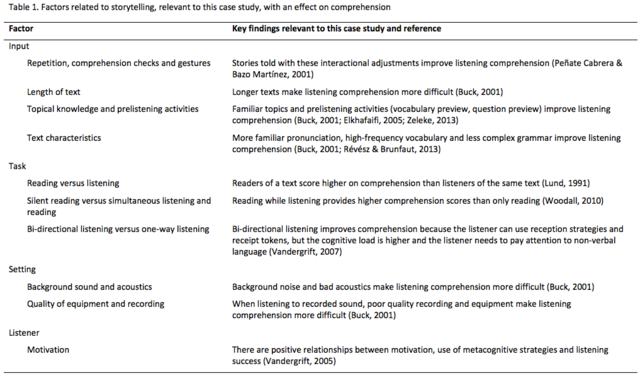
Continued on Next Page »
Ajayi, L. (2011). Video ‘Reading’ and Multimodality: A Study of ESL/Literacy Pupils’ Interpretation of Cinderella from Their Socio-Historical Perspective. The Urban Review, 44(1), 60–89. http://doi.org/10.1007/s11256-011-0175-0
Allen, D., & Tanner, K. (2006). Rubrics: Tools for Making Learning Goals and Evaluation Criteria Explicit for Both Teachers and Learners. CBE - Life Sciences Education, 5(3), 197–203.
Alley, D., & Overfield, D. (2008). An Analysis of the Teaching Proficiency Through Reading and Storytelling (TPRS) Method. In C. Wilkerson & C. M. Cherry (Eds.), Languages for the Nation. Dimension 2008. Selected Proceedings of the 2008 Joint Conference of the Southern Conference on Language Teaching and the South Carolina Foreign Language Teachers’ Association (pp. 13–25). Southern Conference on Language Teaching. Retrieved from http://eric.ed.gov/?id=ED503097
Andrade, H. G. (2005). Teaching with Rubrics: The Good, the Bad, and the Ugly. College Teaching, 53(1), 27–30.
Arter, J. (2000). Rubrics, Scoring Guides, and Performance Criteria: Classroom Tools for Assessing and Improving Student Learning. Presented at the Annual Meeting of the American Educational Research Association, New Orleans, LA. Retrieved from http://eric.ed.gov/?id=ED446100
Artigal, J. M. (1990). Uso-Adquisición de una Lengua Extranjera en el Marco Escolar Entre los Tres y los Seis Años. CL & E: Comunicación, Lenguaje y Educación, (7), 127–144.
Arzamendi, J., Etxeberria, J., Garagorri, X., Elorza, I., Ball, P., & Lindsay, D. (2003). A los 10 Años de Evaluación de la Experiencia Eleanitz-Inglés. Enseñanza-Aprendizaje de las Lenguas Extranjeras en Edades Tempranas, 143–174.
Azpillaga, B., Arzamendi, J., Etxeberria, F., Garagorri, X., Lindsay, D., & Joaristi, L. (2001). Preliminary Findings of a Format-Based Foreign Language Teaching Method for School Children in the Basque Country. Applied Psycholinguistics, 22(1), 35–44.
Birky, B. (2012). Rubrics: A Good Solution for Assessment. Strategies, 25(7), 19–21.
Boston, C. (2002). Understanding Scoring Rubrics: A Guide for Teachers. College Park, MD: ERIC Clearinghouse on Assessment and Evaluation. Retrieved from http://eric.ed.gov/?id=ED471518
Bromer, J. (1995). When I Was a Baby: Autobiographical Talk in a Preschool Classroom. Retrieved from http://search.proquest.com/eric/docview/62552414/abstract/E7835A1856E34006PQ/1?accountid=17248
Bryant, S. C. (2008). How to Tell Stories to Children and Some Stories to Tell. Tennessee: Dodo Press.
Buck, G. (2001). Assessing Listening. Cambridge; New York: Cambridge University Press.
Bulger, M. E., Mayer, R. E., Almeroth, K. C., & Blau, S. D. (2008). Measuring Learner Engagement in Computer-Equipped College Classrooms. Journal of Educational Multimedia and Hypermedia, 17(2), 129–143.
Cain, K., Oakhill, J. V., Barnes, M. A., & Bryant, P. E. (2001). Comprehension Skill, Inference-Making Ability, and Their Relation to Knowledge. Memory & Cognition, 29(6), 850–859.
Cenoz, J. (2011). The Increasing Role of English in Basque Education. English in Europe Today. Sociocultural and Educational Perspectives, 15–30.
Cenoz, J., & Etxague, X. (2011). Third Language Learning and Trilingual Education in the Basque Country. In S. Björklund & I. Bangma, Trilingual Primary Education in Europe: Some Developments With Regard to the Provisions of Trilingual Primary Education in Minority Language Communities of the European Union (pp. 32–44). Ljouwert/Leeuwarden: Fryske Akademy; Mercator Education.
Cheng, H.-F., & Dörnyei, Z. (2007). The Use of Motivational Strategies in Language Instruction: The Case of EFL Teaching in Taiwan. Innovation in Language Learning and Teaching, 1(1), 153–174. http://doi.org/10.2167/illt048.0
Cheyney, D. A. (2010). The Use of Rubrics for Assessment of Student Learning in Higher Education (Doctoral Dissertation). Talbot School of Theology, Biola University, La Mirada, CA. Retrieved from http://search.proquest.com/eric/docview/860152539/abstract/E2CE33D7361F4D35PQ/10?accountid=17248
Ciampa, K. (2012). ICANREAD: The Effects of an Online Reading Program on Grade 1 Students’ Engagement and Comprehension Strategy Use. Journal of Research on Technology in Education, 45(1), 27–59.
Crossley, S. A., Allen, D. B., & McNamara, D. S. (2011). Text Readability and Intuitive Simplification: A Comparison of Readability Formulas. Reading in a Foreign Language, 23(1), 84–101.
Crossley, S. A., Greenfield, J., & McNamara, D. S. (2008). Assessing Text Readability Using Cognitively Based Indices. TESOL Quarterly: A Journal for Teachers of English to Speakers of Other Languages and of Standard English as a Second Dialect, 42(3), 475–493.
Daniel, A. K. (2012). Storytelling across the primary curriculum. Milton Park, Abingdon, Oxon; New York: Routledge.
Davis, E. A., Beyer, C., Forbes, C. T., & Stevens, S. (2011). Understanding Pedagogical Design Capacity Through Teachers’ Narratives. Teaching and Teacher Education: An International Journal of Research and Studies, 27(4), 797–810.
De La Paz, S. (2009). Rubrics: Heuristics for Developing Writing Strategies. Assessment for Effective Intervention, 34(3), 134–146. http://doi.org/10.1177/1534508408318802
Desjardins, E. N. (2011). Small Stories for Learning: A Sociocultural Analysis of Children’s Participation in Informal Science Education (Doctoral Dissertation). Rensselaer Polytechnic Institute, Troy, NY. Retrieved from http://search.proquest.com/eric/docview/1023531028/abstract/D5393755946543FEPQ/1?accountid=17248
Dewitz, P., Leahy, S. B., Jones, J., & Sullivan, P. M. (2010). The Essential Guide to Selecting and Using Core Reading Programs. Newark, DE: International Reading Association.
Dörnyei, Z. (1994). Motivation and Motivating in the Foreign Language Classroom. Modern Language Journal, 78(3), 273–284.
Dörnyei, Z. (2001). New Themes and Approaches in Second Language Motivation Research. Annual Review of Applied Linguistics, 21(1), 43–59.
Dörnyei, Z., & Csizér, K. (1998). Ten Commandments for Motivating Language Learners: Results of an Empirical Study. Language Teaching Research, 2(3), 203–229. http://doi.org/10.1177/136216889800200303
Elkhafaifi, H. (2005). The Effect of Prelistening Activities on Listening Comprehension in Arabic Learners. Foreign Language Annals, 38(4), 505–513. http://doi.org/10.1111/j.1944-9720.2005.tb02517.x
Ellis, G., & Brewster, J. (Eds.). (1991). The Storytelling Handbook for Primary Teachers. Harmondsworth: Penguin Books Ltd.
Ellis, G., & Brewster, J. (2002). Tell it Again! The New Storytelling Handbook for Primary Teachers. Harlow: Penguin English.
Elorza, I. (2005). Ikastolen ‘Eleanitz’ Proiektua: Euskara Ardaztzat Duen Eleaniztasuna. Jakingarriak, (57), 22–27.
Elorza, I., Fano, D., & Tejada, E. (2005). Where’s the Magician?. Donostia: Ikastolen Elkartea.
Elorza, I., & Muñoa, I. (2008). Promoting the Minority Language Through Integrated Plurilingual Language Planning: The Case of the Ikastolas. Language, Culture and Curriculum, 21(1), 85–101. http://doi.org/10.2167/lcc345.0
Euskal Herriko Ikastola EKE (EHI EKE). (2013). Eleanitz Project. Retrieved 4 January 2015, from http://www.eleanitz.org/public/Eleanitz_Project
Fox, M. (2008). Reading Magic: Why Reading Aloud to Our Children Will Change Their Lives Forever (Updated end rev ed.). Orlando, Fla: Harcourt.
Fox, M. (2013). What Next in the Read-Aloud Battle? Win or Lose? The Reading Teacher, 67(1), 4–8. http://doi.org/10.1002/TRTR.1185
Freadman, A. (2014). Fragmented Memory in a Global Age: The Place of Storytelling in Modern Language Curricula. The Modern Language Journal, 98(1), 373–385. http://doi.org/10.1111/j.1540-4781.2014.12067.x
Fritz, C. O., Morris, P. E., & Richler, J. J. (2012). Effect Size Estimates: Current Use, Calculations, and Interpretation. Journal of Experimental Psychology: General, 141(1), 2–18. http://doi.org/10.1037/a0024338
Garagorri, X., Elorza, I., & Lindsay, D. (1997). ELEANITZ Eleaniztasuneko Proiektua, Ingelesa 4 Urtetik Aurrera Irakastea. Jakingarriak, 36, 30–39.
Garvie, E. (1990). Story as Vehicle: Teaching English to Young Children. Clevedon; Philadelphia: Multilingual Matters, Ltd.
Gipuzkoako Ikastolen Elkartea. (2009). Story Projects Tutorial. Story Projects 2. Teacher’s Guide.
Gobierno Vasco. Departamento de Educación, Universidad e Investigación. (2010). Decretos curriculares para la Educación Infantil, Básica y Bachiller en la Comunidad Autónoma del País Vasco. Retrieved from http://www.hezkuntza.ejgv.euskadi.net/r43-2459/es/contenidos/informacion/dig_publicaciones_innovacion/es_curricul/adjuntos/14b_curriculum/320002c_Pub_EJ_curriculum_basica_c.pdf
González Somocurcio, J. (2014). Eleanitz Proiektuak Dituen Hutsuneak. Irakaslearen ikuspegia (Undergraduate Dissertation). Euskal Herriko Unibertsitatea - Universidad del País Vasco, Bilbao. Retrieved from http://hdl.handle.net/10810/14017
Guariento, W., & Morley, J. (2001). Text and Task Authenticity in the EFL Classroom. ELT Journal, 55(4), 347–353. http://doi.org/10.1093/elt/55.4.347
Guilloteaux, M.-J. (2013). Motivational Strategies for the Language Classroom: Perceptions of Korean Secondary School English Teachers. System: An International Journal of Educational Technology and Applied Linguistics, 41(1), 3–14.
Guilloteaux, M. J., & Dörnyei, Z. (2008). Motivating Language Learners: A Classroom-Oriented Investigation of the Effects of Motivational Strategies on Student Motivation. TESOL Quarterly: A Journal for Teachers of English to Speakers of Other Languages and of Standard English as a Second Dialect, 42(1), 55–77.
Hattie, J. (2009). Visible Learning: A Synthesis of Over 800 Meta-Analyses Relating to Achievement. London; New York: Routledge.
Hegler, K. L. (2003). Using General Education Assessment Rubrics to Document Basic Skills and Content Knowledge. Presented at the Annual Meeting of the American Educational Research Association, New Orleans, LA. Retrieved from http://eric.ed.gov/?id=ED472812
Howe, A., & Johnson, J. (1992). Common Bonds: Storytelling in the Classroom. London: Hodder & Stoughton.
Hsiao-fang, C. (2004). A Comparison of Multiple-Choice and Open-Ended Response Formats for the Assessment of Listening Proficiency in English. Foreign Language Annals, 37(4), 544–555.
Ikastolen Elkarteko Eleanitz-Ingelesa Taldea. (2003). Eleanitz-English: Gizarte Zientziak Ingelesez. Bat: Soziolinguistika Aldizkaria, (49), 79–98.
Kazuyoshi, S. (2002). Contagious Storytelling. The Language Teacher, 26(Special Issue: The Narrative Mind), 15–25.
Keane, J. T. (2010). Student Multimedia Autobiographies: The Roles of Technology, Personal Narrative, and Signifying Practices (Doctoral Dissertation). University of North Carolina, Chapel Hill, NC. Retrieved from http://search.proquest.com/eric/docview/898324097/abstract/D07BEE47EFD84FB3PQ/1?accountid=17248
Kobayashi, M. (2012). A Digital Storytelling Project in a Multicultural Education Class for pre-Service Teachers. Journal of Education for Teaching, 38(2), 215–219. http://doi.org/10.1080/02607476.2012.656470
Kohn, A. (2006). The Trouble With Rubrics. English Journal,High School Edition, 95(4), 12–15.
Kouame, J. B. (2010). Using Readability Tests to Improve the Accuracy of Evaluation Documents Intended for Low-Literate Participants. Journal of MultiDisciplinary Evaluation, 6(14), 132–139.
Kugelmass, J. W. (2000). Subjective Experience and the Preparation of Activist Teachers: Confronting the Mean Old Snapping Turtle and the Great Big Bear. Teaching and Teacher Education, 16(2), 179–194.
Lasagabaster Herrarte, D. (2011). Basque as a Minority Language and English as a Foreign Language: Are They Complementary Languages in the Basque Educational System? Annales-Anali Za Istrske in Mediteranske Studije, 21(1), 93–100.
Le Fevre, D. M. (2011). Creating and Facilitating a Teacher Education Curriculum Using Preservice Teachers’ Autobiographical Stories. Teaching and Teacher Education: An International Journal of Research and Studies, 27(4), 779–787.
Leggo, C. (2007). Writing Truth in Classrooms: Personal Revelation and Pedagogy. International Journal of Whole Schooling, 3(1), 27–37.
Liu, C.-C., Wu, L. y., Chen, Z.-M., Tsai, C.-C., & Lin, H.-M. (2014). The Effect of Story Grammars on Creative Self-Efficacy and Digital Storytelling. Journal of Computer Assisted Learning, 30(5), 450–464. http://doi.org/10.1111/jcal.12059
Livingston, M. (2012). The Infamy of Grading Rubrics. English Journal,High School Edition, 102(2), 108–113.
Lund, R. J. (1991). A Comparison of Second Language Listening and Reading Comprehension. The Modern Language Journal, 75(2), 196–204. http://doi.org/10.2307/328827
McKendry, M. G., & Murphy, V. A. (2011). A Comparative Study of Listening Comprehension Measures in English as an Additional Language and Native English-Speaking Primary School Children. Evaluation & Research in Education, 24(1), 17–40. http://doi.org/10.1080/09500790.2010.531702
Meddings, L., & Thornbury, S. (2009). Teaching Unplugged. Dogme in English Language Teaching. Peaslake: Delta Publishing.
Menezes, H. (2012). Using Digital Storytelling to Improve Literacy Skills. In Proceedings of the International Association for Development of the Information Society (Iadis) International Conference on Cognition and Exploratory Learning in Digital Age (Celda) (Madrid, Spain, October19-21, 2012). Madrid, Spain: International Association for the Development of the Information Society. Retrieved from http://eric.ed.gov/?id=ED542821
Mertler, C. A. (2001). Designing Scoring Rubrics for Your Classroom. Practical Assessment, Research & Evaluation, 7(25).
Morgan, G. L. (2008). Improving Student Engagement: Use of the Interactive Whiteboard as an Instructional Tool to Improve Engagement and Behavior in the Junior High School Classroom (Doctoral Dissertation). Liberty University, Lynchburg, VA. Retrieved from http://digitalcommons.liberty.edu/cgi/viewcontent.cgi?article=1140&context=doctoral&sei-redir=1&referer=http%3A%2F%2Fscholar.google.es%2Fscholar%3Fhl%3Den%26q%3Dstudent%2Bengagement%2Bchecklist%26btnG%3D%26as_sdt%3D1%252C5#search=%22student%20engagement%20checklist%22
Morgan, J. (1983). Once Upon a Time: Using Stories in the Language Classroom. Cambridge; New York: Cambridge University Press.
Moskal, B. M. (2000a). Scoring Rubrics Part I: What and When. ERIC/AE Digest. ERIC Digests. Retrieved from http://eric.ed.gov/?id=ED446110
Moskal, B. M. (2000b). Scoring Rubrics: What, When and How? Practical Assessment, Research & Evaluation, 7(3). Retrieved from http://search.proquest.com/eric/docview/62234228/E2CE33D7361F4D35PQ/34?accountid=17248
Moskal, B. M. (2003). Developing Classroom Performance Assessments and Scoring Rubrics - Part II. ERIC Digest. ERIC Digests. Retrieved from http://eric.ed.gov/?id=ED481715
Msila, V. (2011). Autobiographical Narrative in a Language Classroom: a Case Study in a South African School. Language and Education, 26(3), 233–244. http://doi.org/10.1080/09500782.2011.636820
Nicholson, S. J. (2013). Influencing Motivation in the Foreign Language Classroom. Journal of International Education Research, 9(3), 277.
Panadero, E., & Jonsson, A. (2013). The Use of Scoring Rubrics for Formative Assessment Purposes Revisited: A Review. Educational Research Review, 9, 129–144. http://doi.org/10.1016/j.edurev.2013.01.002
Paran, A., & Watts, E. (Eds.). (2003). Storytelling in ELT. Whitstable: IATEFL.
Park, G. (2011). Adult English Language Learners Constructing and Sharing Their Stories and Experiences: The Cultural and Linguistic Autobiography Writing Project. TESOL Journal, 2(2), 156–172.
Park, G.-P. (2004). Comparison of L2 Listening and Reading Comprehension by University Students Learning English in Korea. Foreign Language Annals, 37(3), 448–458.
Peacock, M. (1997). The Effect of Authentic Materials on the Motivation of EFL Learners. ELT Journal, 51(2), 144–156. http://doi.org/10.1093/elt/51.2.144
Peñate Cabrera, M., & Bazo Martínez, P. (2001). The Effects of Repetition, Comprehension Checks, and Gestures, on Primary School Children in an EFL Situation. ELT Journal, 55(3), 281–288. http://doi.org/10.1093/elt/55.3.281
Pennac, D. (2008). Como una Novela (12th ed.). Barcelona, Spain: Anagrama.
Petit, S., Mougenot, C., & Fleury, P. (2011). Stories on Research, Research on Stories. Journal of Rural Studies, 27(4), 394–402.
Pilon, E. M. (1993). Autobiography and Writing Across the Curriculum: Bringing ‘Life’ to Disciplinary Writing (p. 24). Presented at the Annual Meeting of the Conference on College Composition and Communication, San Diego, CA. Retrieved from http://search.proquest.com/eric/docview/62772270/abstract/27539FC981C048E9PQ/1?accountid=17248
Quackenbush, J. L. (2010). Writing (and Re-Writing) a Gendered Educational Life: Envisioning Possibilities for Teachers’ Autobiographical Texts (Doctoral Dissertation). Columbia University, New York, NY. Retrieved from http://search.proquest.com/eric/docview/881461769/abstract/2A8F1D52FB314668PQ/1?accountid=17248
Read, C. (2007). 500 Activities for the Primary Classroom. Immediate Ideas and Solutions. Oxford: Macmillan Education.
Reason, P., & Bradbury-Huang, H. (2001). Introduction: Inquiry and Participation in Search of a World Worthy of Human Inspiration. In P. Reason & H. Bradbury-Huang (Eds.), Handbook of Action Research: Participative Inquiry and Practice (pp. 1–13). London; Thousand Oaks, Calif: SAGE Publications Ltd.
Révész, A., & Brunfaut, T. (2013). Text Characteristics of Task Input and Difficulty in Second Language Listening Comprehension. Studies in Second Language Acquisition, 35(1), 31–65. http://doi.org/http://dx.doi.org/10.1017/S0272263112000678
Rivera Maulucci, M. S. (2011). Language Experience Narratives and the Role of Autobiographical Reasoning in Becoming an Urban Science Teacher. Cultural Studies of Science Education, 6(2), 413–434.
Rossiter, M. (2002). Narrative and Stories in Adult Teaching and Learning. ERIC Digest. ERIC Digests, 4.
Rossiter, M., & Clark, M. C. (2007). Narrative and the Practice of Adult Education. Malabar, FL: Krieger Publishing Company.
Rubin, J. (1994). A Review of Second Language Listening Comprehension Research. The Modern Language Journal, 78(2), 199–221. http://doi.org/10.1111/j.1540-4781.1994.tb02034.x
Savvidou, C. (2010). Storytelling as Dialogue: how Teachers Construct Professional Knowledge. Teachers and Teaching, 16(6), 649–664. http://doi.org/10.1080/13540602.2010.517682
Schmidt, M., & Knowles, G. J. (1994). Four Women’s Stories of ‘Failure’ As Beginning Teachers. (p. 40). Presented at the Annual Meeting of the American Educational Research Association, New Orleans, LA. Retrieved from http://search.proquest.com/eric/docview/62708098/abstract/7F3F302A8BBA48C1PQ/1?accountid=17248
Scrivener, J. (1994). Learning Teaching: a Guidebook for English Language Teachers. Oxford: Heinemann.
Taeschner, T., Gheorghiu, I., & Colibaba, A. (2013). ‘The Narrative Format’for Learning and Teaching Languages to Children and Adults. Synergy, (2), 223–235.
Taguchi, K. (2006). Is Motivation a Predictor of Foreign Language Learning? International Education Journal, 7(4), 560–569.
Thornbury, S. (2001). Point and Counterpoint. The Unbearable Lightness of EFL. ELT Journal, 55(4), 391–396. http://doi.org/10.1093/elt/55.4.391
Turner, J. C., Christensen, A., Kackar-Cam, H. Z., Trucano, M., & Fulmer, S. M. (2014). Enhancing Students’ Engagement Report of a 3-Year Intervention With Middle School Teachers. American Educational Research Journal, 51(6), 1195–1226. http://doi.org/10.3102/0002831214532515
Turner, M. (1996). The Literary Mind. New York: Oxford University Press.
Vandergrift, L. (2005). Relationships Among Motivation Orientations, Metacognitive Awareness and Proficiency in L2 Listening. Applied Linguistics, 26(1), 70–89. http://doi.org/10.1093/applin/amh039
Vandergrift, L. (2007). Recent Developments in Second and Foreign Language Listening Comprehension Research. Language Teaching, 40(3), 191–210.
Walters, L. M., Green, M. R., Wang, L., & Walters, T. (2011). From Heads to Hearts: Digital Stories as Reflection Artifacts of Teachers’ International Experience. Issues in Teacher Education, 20(2), 37–52.
White, B. F. (1995). Effects of Autobiographical Writing before Reading on Students’ Responses to Short Stories. Journal of Educational Research, 88(3), 173–184.
Whittaker, C. R., Salend, S. J., & Duhaney, D. (2001). Creating Instructional Rubrics for Inclusive Classrooms. Teaching Exceptional Children, 34(2). Retrieved from http://search.proquest.com/eric/docview/1437904047/abstract/E2CE33D7361F4D35PQ/31?accountid=17248
Wilson, D. E. (1993). Composing Experience and Knowledge: Narrative as a Critical Instrument in English Teacher Preparation. Presented at the Annual Meeting of the National Council of Teachers of English, Pittsburgh, PA. Retrieved from http://search.proquest.com/eric/docview/62797112/abstract/6E90A3610CDE429EPQ/1?accountid=17248
Woodall, B. (2010). Simultaneous Listening and Reading in ESL: Helping Second Language Learners Read (and Enjoy Reading) More Efficiently. TESOL Journal, 1(2), 186–205. http://doi.org/10.5054/tj.2010.220151
Wright, A. (1995). Storytelling With Children. Oxford: Oxford University Press.
Wu, R. (1994). ESL Students Writing Autobiographies: Are There Any Connections? Presented at the Annual Meeting of the Rhetoric Society of America, Louisville, KY. Retrieved from http://search.proquest.com/eric/docview/62702220/abstract/9C6FA8564B3F4EB8PQ/1?accountid=17248
Yoshina, J. M., & Harada, V. H. (2007). Involving Students in Learning Through Rubrics. Library Media Connection, 25(5), 10–14.
Zamanian, M., & Heydari, P. (2012). Readability of Texts: State of the Art. Theory and Practice in Language Studies, 2(1), 43–53.
Zaro, J. J., & Salaberri, S. (1995). Storytelling. Oxford: Heinemann.
Zeleke, A. S. (2013). Does Viewing Test Items at Different Times Matter in English for Academic Purpose Listening Test? Modern Journal of Language Teaching Methods, 3(2), 63–77.
Appendix A – Key new vocabulary in the stories
This appendix contains the key vocabulary in each story that the participants were likely to encounter for the first time. The prelistening phase introduced the key vocabulary.
Key vocabulary that was addressed in the prelistening phase of the autobiographical story: hiking, mountain range, tent, hut, sleeping bag, bunk beds, onigiri.
Key vocabulary that was addressed in the prelistening phase of the ELEANITZ story: magician, magic show, MC (master of ceremonies), worried, orchestra, audience, circus, clowns, jokes, troupe.
Appendix B – The autobiographical story
Hiking in Japan
A few summers ago, my husband and I spent six weeks in Japan, one of them hiking in the Japanese Alps, a long mountain range about 3,000 metres high.
The day before we started hiking, we prepared our rucksacks and filled them with all the things we would need: the tent, our sleeping bags, the little stove, water bottles, a bit of cutlery, the rain jackets, a few spare clothes, a bit of soap and our toothbrushes. And, of course, we needed food.
So, we went to the supermarket. Unfortunately, we spoke only a few words of Japanese, we couldn’t read anything, and we found nobody who spoke English. Everything looked very unfamiliar to us in the supermarket. We needed to take some sandwiches for lunch. But, guess what? Japanese people don’t eat bread, so we had to find something else. The closest thing to sandwiches is onigiri, rice balls. So, we bought onigiri and some cakes. My husband said: “I hope the mountain huts along the path will sell food. Otherwise, we will have to come down in two days, instead of seven.”
The next day we started hiking for seven days in the Japanese Alps. The first day was the hardest, because we had to climb almost 2,000 metres. We couldn’t read Japanese maps or signs, so we weren’t sure if we would find the path easily. Luckily, the path was very clear, so we didn’t get lost.
On this first day, we found a small mountain hut that sold food, where other Japanese hikers were buying noodles and onigiri. So, I thought: “Food will be easy to get along the way.”
Most days we slept in our tent, close to other hikers. We all got up at the same time in the morning, then started walking at a different pace, and we met again in the evening on the next campsite. So, they were our “tent-neighbours,” and we became friends with two of them, even if we couldn’t speak Japanese, and they didn’t speak English.
One afternoon, it started to rain, so we decided to go to a mountain hut, instead of sleeping in the tent. We had a nice supper, and slept on bunk beds. The next morning, we saw that the workers in the mountain hut were very nervous, walking up and down and talking on the radio. Finally, some other hikers came carrying on their shoulders a man who looked sick; his face was blue. His friends told us with signals that he had a heart attack. Then, we heard a helicopter, and we realised that it was coming to rescue the sick man. A man was dropped from the helicopter with a cable, he tied the sick man, and both of them were lifted up with the cable again.
After the rescue, it was sunny again. We left the mountain hut and continued with our walk. When we got to the next campsite, we met our two friends. That night we had dinner together, and we shared their barbeque meat and our onigiri, together with some sake they had. It was their last night in the Japanese Alps, and the same for us.
The next day we walked down another 2,000 metres, and said goodbye to our Japanese friends. I never learned their names, but we were friends for seven days.
Appendix C – Criteria followed to adapt input and to design the comprehension questionnaires
Listening comprehension is a very complex process. Much of its details remain unknown and, consequently, assessing it is also difficult. An effort was made to shape the autobiographical story in such a way that its degree of difficulty would be equal to that of the ELEANITZ story.
Nevertheless, the circumstances under which the empirical research took place made it impossible to take into account all the factors that could have been addressed (Révész & Brunfaut, 2013; Rubin, 1994) if there had been more time to analyse the degree of difficulty of the ELEANITZ story and adapt the autobiographical story to match it.
On the other hand, although the level or degree of difficulty of the listening activity will be set by the task itself, and not the material (Guariento & Morley, 2001; Scrivener, 1994; Wright, 1995), some of the factors determining task difficulty are related to text characteristics. In general, complexity of the language, cognitive load and performance conditions are considered the factors that should receive special attention in this sense (as cited in Guariento & Morley, 2001).
Regarding text difficulty, the following guidelines were taken into account to set the complexity of the language and the cognitive load in order to make input more comprehensible in the autobiographical story (Buck, 2001; Ellis & Brewster, 2002; Révész & Brunfaut, 2013; Rubin, 1994):
- Unfamiliar words were avoided, using more high-frequency vocabulary whenever it was deemed suitable, and idioms and keywords that might be unfamiliar were introduced before telling the story. Redundancy of words new to listeners was used throughout the narration.
- Regarding verb tense, the simple past was used. Structures were kept simple, and sentences short.
- Story events were referred in chronological order, following a linear order. In addition, wherever necessary, the sequence of events was reinforced using appropriate transition words (first, then, before etc.). Transition words were used to improve cohesion. Direct speech was used when it was thought it would make the story easier to follow. Finally, the number of events and people in the story was kept short.
- Additionally, while telling the story, visual aid was used to provide a schema-based approach and students were encouraged to ask for further clarification whenever they did not understand something in the story, in order to promote the negotiation of comprehensible input along the storytelling.
The comprehension questionnaires for the two stories were designed following the extensive analysis on listening assessment carried out by Buck (2001) and the review of further research literature on the subject published later on (Vandergrift, 2007). The following criteria were taken into account to design the comprehension questionnaires concerning task difficulty (Buck, 2001):
- The amount of information to be processed.
- The location of the information to be processed within the text, as integrating scattered information is more difficult.
- The type of content to be produced, as recalling literal content is easier than summarising.
- The relationship between the order of the questions and the order of the information in the story, because the task is easier when both are the same.
- The order of the questions in relation to their difficulty, as the task is easier when the questions are arranged starting from the easiest and progressing to the most difficult.
Appendix D – The questionnaires and the post-test survey
1. The autobiographical story
Set of questions regarding the autobiographical story:
- Whom did Miren go hiking with in the Japanese Alps?
- Her Japanese friend
- Her husband
- Her brother
- Her neighbour
- Which of the following did Miren put in her rucksack?
- A stove, a rain jacket, some deodorant
- Sunglasses, a tent, a bit of soap
- A water bottle, a hat, some spare clothes
- A sleeping bag, some cutlery, a toothbrush
- How much did Miren climb on her first day in the Japanese Alps?
- 1 000 metres
- 2 000 metres
- 3 000 metres
- 4 000 metres
- What was the story about?
- It was about the different types of food in Japan
- It was about the friends Miren made in Japan
- It was about Miren’s holidays in Japan and what happened to her in the Japanese Alps
- It was about a man who had a heart attack and had to be rescued in a helicopter
- Where did Miren get the food she ate during her days in the Japanese Alps?
- She bought everything in the supermarket
- She always ate in the mountain huts
- She got part in the supermarket and part in the mountain huts
- She got part in the supermarket, part in the mountain huts and part from her Japanese friends
- After having listened to this story, if you went to the Japanese Alps, which would be the most important three things you would put in your rucksack?
- A sleeping bag, a rain jacket and a bit of food
- A lot of food, some spare clothes and a toothbrush
- A tent, a sleeping bag and some soap
- A water bottle, some cutlery and a stove
- What do you think is the message of this story, the reason why Miren chose it? Why do you think that?
- Does this story remind you of anything that happened to you? Explain what happened shortly, please.
2. The story “Where's the magician?”
Set of questions on the story “Where's the magician?”:
- How did Peggy find out about the show of the Tilly Troupe?
- Her mum heard it on the radio
- Peggy read it on the school magazine
- Her mum read it on the newspaper
- David told Peggy about it
- Who called whom to go to the Tilly Troupe’s show?
- First, Peggy called David. Then, David called all the others
- Peggy’s mum called all her friends
- First, David called Peggy. Then, Peggy called all the others
- First, Peggy called David. Then, each called two friends
- When was the show going to start?
- At a quarter to five
- At five o’clock
- At a quarter past five
- At half past five
- Choose the sentence which best summarises the story
- The story was about a magician who got lost and didn’t arrive on time for the show
- The story was about Peggy and her friends, and what happened to them when they went to see the Tilly Troupe’s show
- The story was about Peggy and her friends, and how they organised to go to a show
- The story was about the clowns Coco and Jolly, who were making jokes and got cross in the end
- What had the Tilly Troupe planned to do in the show?
- The Tilly Troupe had planned to do magic tricks, clown jokes, and singing and dancing
- The Tilly Troupe had planned to play with the orchestra and dance
- The Tilly Troupe had planned to do horse riding tricks
- The Tilly Troupe had planned to do some clown jokes and magic tricks
- After having listened to this story, if you wanted to go to the Tilly Troupe’s show, what are the most important 3 things you would do before:
- Phone a friend, buy a ticket, and learn a joke
- Read the newspaper, arrive on time for the show, and learn a song
- Buy a ticket, arrive on time for the show, and learn a card trick
- Learn a card trick, a song and a joke
- Do you think the story is believable? Why do you think that?
- Has anything similar ever happened to you? Explain what happened shortly, please.
3. The post-test survey
- Which story did you like more?
- The story about Miren hiking in Japan
- “Where's the magician?”
- If your regular teacher, Idoia, asked you to summarise one of the stories in class, which would you choose? Why?
Appendix E – The Rubrics
This case study met two important criteria which supported using a rubric as the assessment tool for the comprehension questionnaires (Allen & Tanner, 2006; Andrade, 2005; Arter, 2000; Moskal, 2000a; Panadero & Jonsson, 2013): it dealt with a complex process – listening comprehension – which demanded a qualitative approach in the assessment, and it was intended to give the participants feedback on the results of the questionnaires in the form of a formative assessment, which would give them some guidance as to how to improve their listening comprehension. Rubrics are widely used in all stages of education, and they are not free of controversy, having both detractors (e.g. Kohn, 2006) and advocates (e.g. Livingston, 2012).
The rubric was partially designed in the form of an instructional rubric (Andrade, 2005; Whittaker et al., 2001). Unfortunately, the circumstances of the case study forced to use it as a scoring rubric.
The three local questions of each questionnaire were assessed with a holistic rubric, while the analytic rubric was considered more adequate to assess the four global questions, as each one of them dealt with a different aspect of comprehension. For the purpose of giving feedback to the participants, the rubric was slightly changed, in order to make it more self-explanatory. In particular, the holistic section of the rubric, which is applied to the first three questions, was turned into an analytic rubric. Besides, the language used in the rubric was reviewed in an attempt to bring it closer to student language, as suggested by Whittaker at al. (2001) and images were introduced to help communicate the contents.
The following pages contain the final rubrics, completely analytic and adapted in order to be handed out to the participants as feedback on the activities.
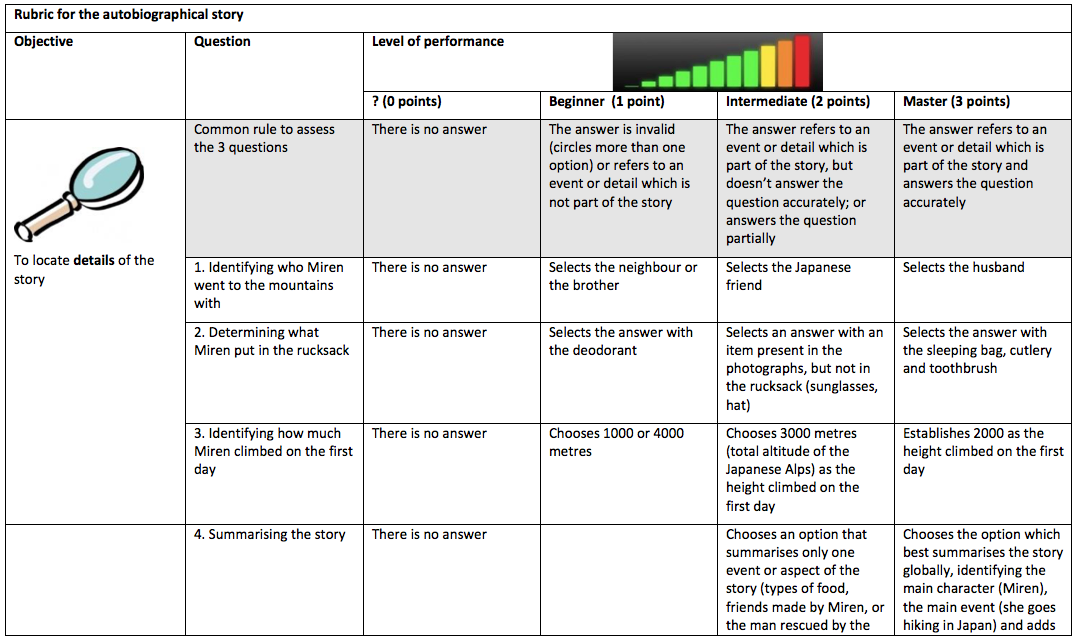
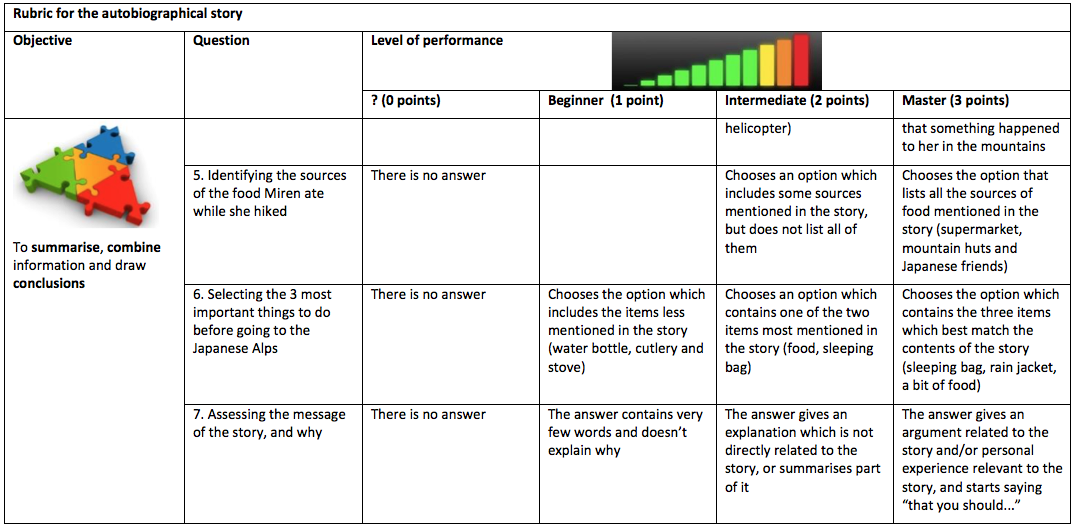
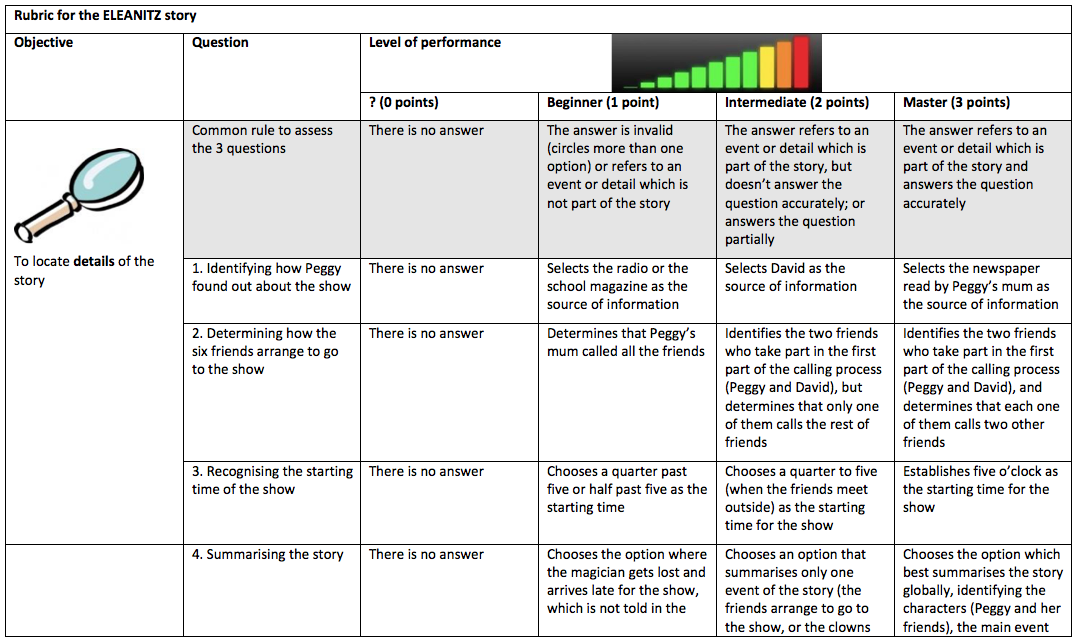
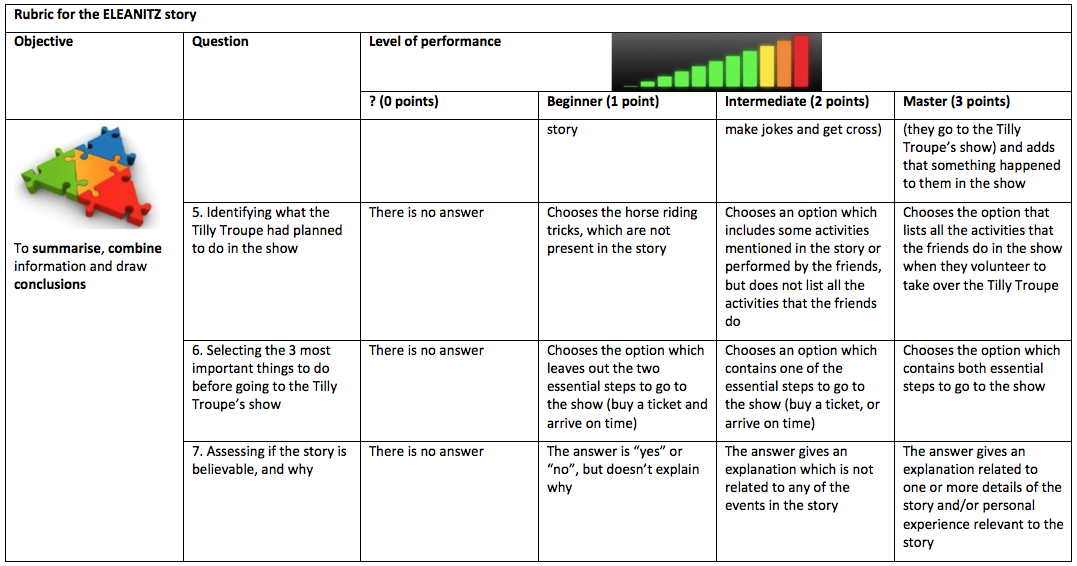
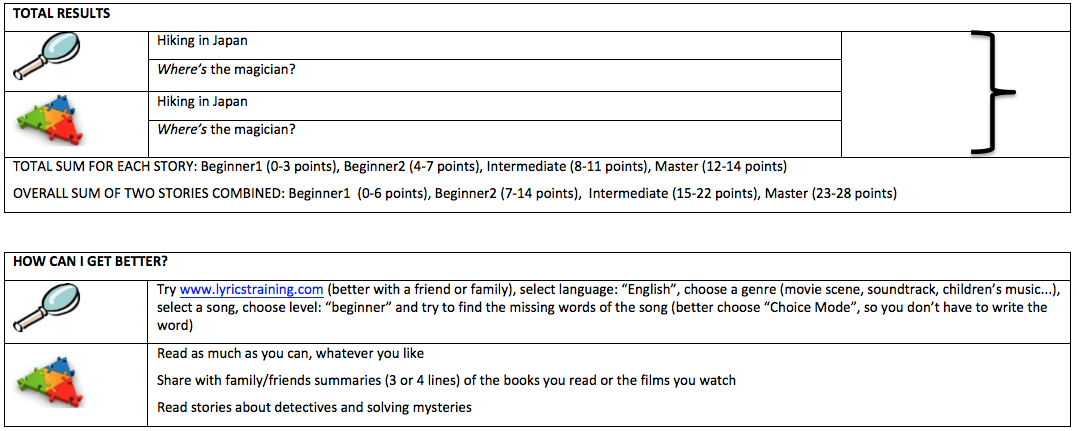
Appendix F – Comprehension scores per participant
The table in the following page shows the scores obtained by each participant in both stories.
